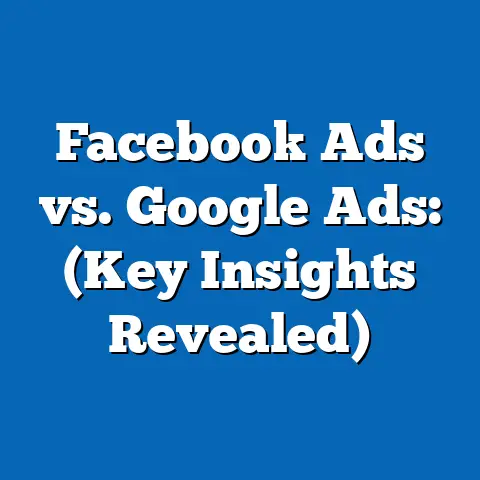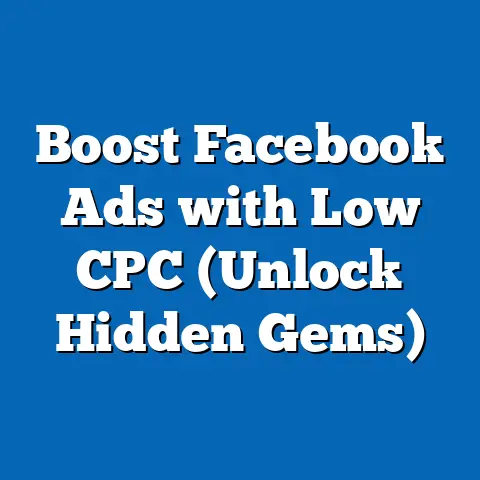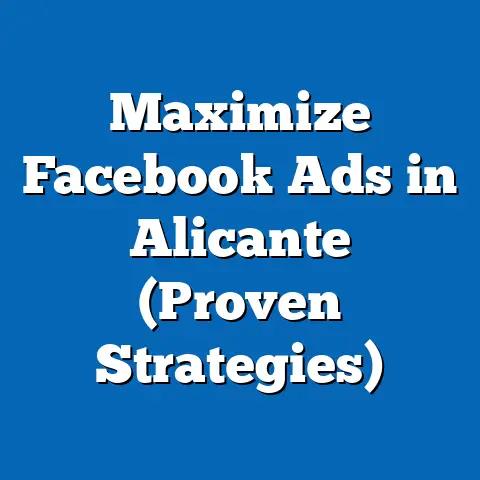Master Image Strategies for Facebook Ads (Pro Techniques)
I remember when I first started running Facebook ads, I thought I could just slap any old image on an ad, write some catchy copy, and watch the leads roll in. Boy, was I wrong! It didn’t take long for me to realize that the image is often the first thing people see, and it’s what grabs their attention (or doesn’t) as they scroll through their feeds. According to a recent study by HubSpot, posts with images produce 650% higher engagement than text-only posts. That’s a massive difference! This fact underscores the critical role that images play in capturing audience attention on platforms like Facebook.
1. Understanding Facebook’s Ad Ecosystem
Before diving into the nitty-gritty of image strategies, it’s essential to understand the landscape of Facebook’s advertising platform.
Brief Overview of Facebook’s Advertising Platform
Facebook’s advertising platform is vast and complex, offering a wide range of targeting options, ad formats, and placement opportunities. From reaching specific demographics to retargeting website visitors, the platform provides a powerful toolkit for marketers.
I’ve found that a lot of advertisers jump straight into creating ads without fully understanding how the platform works. Take the time to familiarize yourself with the different campaign objectives, ad sets, and ad formats. This foundational knowledge will make it easier to create image strategies that align with your overall marketing goals.
Explanation of How Image Quality Impacts Ad Performance
Image quality is paramount. A blurry, pixelated, or poorly composed image can instantly turn potential customers away. Think of your ad image as your first impression. You want to make it a good one!
Facebook’s algorithm also takes image quality into account. Ads with high-quality images are more likely to be shown to a wider audience, while those with low-quality images may be penalized.
The Role of Facebook’s Algorithm in Prioritizing Engaging Visual Content
Facebook’s algorithm is designed to prioritize content that users find engaging. This means that ads with images that capture attention, evoke emotion, and encourage interaction are more likely to be seen by your target audience.
I’ve noticed that ads with visually appealing images tend to have higher click-through rates and lower costs per click. This is because the algorithm recognizes that users are responding positively to the ad and rewards it with increased visibility.
Takeaway: Understanding Facebook’s ad ecosystem and the importance of image quality is the first step towards creating effective image strategies.
2. The Psychology of Images in Advertising
Images are powerful tools for communication because they tap into our emotions and bypass the rational mind. Understanding the psychology behind why images are so effective can help you create ads that resonate with your target audience on a deeper level.
Discuss the Psychological Principles Behind Why Images Are More Effective Than Text
Images are processed much faster than text. Studies have shown that the human brain can process images in as little as 13 milliseconds. This means that your ad image has a fraction of a second to grab someone’s attention as they scroll through their feed.
Images also evoke emotions more effectively than text. A well-chosen image can trigger feelings of joy, excitement, fear, or nostalgia, which can influence purchasing decisions.
Explore the Emotional Responses Elicited by Compelling Visuals
The emotional response that your ad image evokes will depend on your target audience and your brand’s message. For example, if you’re selling travel packages, you might use images of exotic beaches and breathtaking landscapes to evoke feelings of wanderlust and relaxation.
I once worked with a client who sold home security systems. We used images of families laughing and playing in their homes to evoke feelings of safety and security. The campaign was incredibly successful because it tapped into people’s desire to protect their loved ones.
Introduce Concepts Such as Color Psychology and Imagery Symbolism
Color psychology is the study of how different colors affect human behavior. Each color has its own unique associations and can evoke different emotions. For example, blue is often associated with trust and reliability, while red is associated with excitement and energy.
Imagery symbolism involves using images to represent abstract concepts or ideas. For example, a dove might be used to symbolize peace, while a lion might be used to symbolize strength.
Takeaway: Understanding the psychology of images can help you create Facebook ads that are more engaging, memorable, and persuasive.
3. Types of Images that Work Best on Facebook
Not all images are created equal. Some types of images are more effective than others on Facebook, depending on your target audience, your product or service, and your advertising goals.
Analyze Different Types of Images: Product Photos, Lifestyle Shots, User-Generated Content, Infographics, and Memes
- Product Photos: These are images that showcase your product or service. They should be high-quality, well-lit, and accurately represent what you’re selling.
- Lifestyle Shots: These are images that show your product or service being used in a real-life setting. They can help potential customers visualize themselves using your product and see how it can improve their lives.
- User-Generated Content (UGC): These are images that are created by your customers. They can be a powerful form of social proof and can help build trust with potential customers.
- Infographics: These are visual representations of data or information. They can be a great way to educate your target audience about your product or service and demonstrate its value.
- Memes: These are humorous images or videos that are often shared on social media. They can be a great way to inject some personality into your ads and make them more engaging.
Provide Examples of Successful Campaigns that Utilized Each Type
I’ve seen countless successful campaigns that have utilized each of these image types. For example, a clothing retailer might use product photos to showcase their latest collection, lifestyle shots to show people wearing their clothes in different settings, and UGC to feature customers who are happy with their purchases.
A software company might use infographics to explain the benefits of their product and memes to poke fun at common industry challenges.
Discuss the Benefits and Drawbacks of Each Image Type in Different Advertising Contexts
Each image type has its own set of benefits and drawbacks. Product photos are great for showcasing your product, but they can be boring if they’re not done well. Lifestyle shots are more engaging, but they can be expensive to produce. UGC is authentic and trustworthy, but it can be difficult to control. Infographics are informative, but they can be time-consuming to create. Memes are funny, but they can be risky if they’re not appropriate for your brand.
Takeaway: Experiment with different image types to see what resonates best with your target audience and aligns with your advertising goals.
4. Creating High-Quality Visuals
Creating high-quality visuals is essential for making a positive impression on potential customers and maximizing the effectiveness of your Facebook ads.
Detail the Technical Aspects of Creating Images: Resolution, Aspect Ratios, and Formats
- Resolution: Your images should be high-resolution, meaning they have a lot of pixels per inch. This will ensure that they look sharp and clear on all devices. I usually recommend a minimum resolution of 1200 x 628 pixels for Facebook ads.
- Aspect Ratios: The aspect ratio of your images is the ratio of their width to their height. Facebook supports a variety of aspect ratios, depending on the ad placement. For example, square images (1:1 aspect ratio) work well in the News Feed, while vertical images (9:16 aspect ratio) are ideal for Stories.
- Formats: Facebook supports a variety of image formats, including JPEG, PNG, and GIF. JPEG is a good choice for photographs, while PNG is better for graphics and logos. GIFs can be used to create short animations.
Tips for Using Graphic Design Tools (Like Canva, Adobe Spark) to Create Professional-Looking Visuals
You don’t need to be a professional graphic designer to create high-quality visuals for your Facebook ads. There are a variety of user-friendly graphic design tools available, such as Canva and Adobe Spark, that make it easy to create professional-looking images.
These tools offer a wide range of templates, fonts, and graphics that you can use to create your own custom visuals. They also provide helpful tutorials and tips to guide you through the design process.
Importance of Consistency in Branding Elements (Colors, Fonts, Logos)
Consistency in branding elements is crucial for building brand recognition and creating a cohesive brand identity. Your ad images should use the same colors, fonts, and logos as your website and other marketing materials.
This will help potential customers recognize your brand and associate it with your products or services. It will also create a sense of trust and professionalism.
Takeaway: Invest in creating high-quality visuals that are technically sound, professionally designed, and consistent with your branding.
5. Image Optimization Techniques
Once you’ve created your ad images, it’s important to optimize them for performance. This involves A/B testing different images, optimizing them for faster loading times, and analyzing their performance metrics.
Discuss the Importance of A/B Testing Different Images to Find What Resonates with the Audience
A/B testing, also known as split testing, is the process of comparing two versions of an ad to see which one performs better. In the context of image optimization, you can A/B test different images to see which ones resonate best with your target audience.
For example, you might test two different lifestyle shots to see which one generates more clicks or conversions. You can also test different colors, fonts, and text overlays.
Strategies for Optimizing Images for Faster Loading Times Without Compromising Quality
Faster loading times are crucial for a good user experience. If your ad images take too long to load, people may get impatient and scroll past them.
You can optimize your images for faster loading times by compressing them without compromising quality. There are a variety of online tools that can help you do this, such as TinyPNG and ImageOptim.
You can also use a Content Delivery Network (CDN) to serve your images from servers that are located closer to your target audience.
Explain How to Use Facebook’s Ad Manager to Analyze Image Performance Metrics
Facebook’s Ad Manager provides a wealth of data about the performance of your ad images. You can use this data to track metrics such as impressions, clicks, click-through rate (CTR), cost per click (CPC), and conversions.
By analyzing these metrics, you can identify which images are performing well and which ones need improvement. You can also use this data to refine your targeting and bidding strategies.
Takeaway: Continuously optimize your ad images for performance by A/B testing, compressing them for faster loading times, and analyzing their performance metrics.
6. Leveraging User-Generated Content (UGC)
User-generated content (UGC) is any content that is created by your customers, such as photos, videos, and reviews. UGC can be a powerful tool for building trust, enhancing engagement, and driving conversions.
The Power of Authenticity: Why UGC Can Enhance Trust and Engagement
UGC is seen as more authentic and trustworthy than traditional advertising. People are more likely to believe what their peers say about your product or service than what you say about it yourself.
UGC can also enhance engagement by creating a sense of community around your brand. When customers see their own content being featured in your ads, they feel valued and appreciated.
How to Encourage Customers to Share Their Own Images Featuring Your Products
There are a variety of ways to encourage customers to share their own images featuring your products.
- Run a contest or giveaway: Ask customers to submit photos of themselves using your product for a chance to win a prize.
- Create a hashtag: Encourage customers to use a specific hashtag when sharing photos of your product on social media.
- Feature customer photos on your website and social media channels: This will show customers that you value their content and encourage others to share their own photos.
Legal Considerations When Using UGC in Ads
Before using UGC in your ads, it’s important to get permission from the content creator. You should also make sure that the content is accurate and does not violate any copyright laws.
It’s also a good idea to have a clear policy in place that outlines how you will use UGC and what rights customers have.
Takeaway: Leverage the power of user-generated content to build trust, enhance engagement, and drive conversions.
7. Ad Placement and Image Size Considerations
Facebook offers a variety of ad placements, each with its own unique characteristics and requirements. It’s important to tailor your images to the specific ad placement to ensure that they look their best and perform well.
Overview of Various Ad Placements on Facebook (News Feed, Stories, Marketplace, etc.)
- News Feed: This is the main feed that people see when they log into Facebook. Ads in the News Feed appear alongside organic content from friends and family.
- Stories: These are short-form videos and images that disappear after 24 hours. Ads in Stories are full-screen and immersive.
- Marketplace: This is a platform where people can buy and sell goods. Ads in Marketplace appear alongside listings from other sellers.
- Right Column: These are ads that appear in the right column of the Facebook website. They are typically smaller and less visually prominent than ads in the News Feed.
- Instant Articles: These are articles that load instantly on Facebook. Ads in Instant Articles appear within the article content.
Recommended Image Sizes and Formats for Each Placement
Facebook provides specific recommendations for image sizes and formats for each ad placement. It’s important to follow these recommendations to ensure that your images look their best and are not cropped or distorted.
You can find the latest recommendations in Facebook’s Ad Specs Guide.
How to Tailor Images Based on Where the Ad Will Be Displayed
In addition to following Facebook’s recommendations for image sizes and formats, you should also tailor your images to the specific ad placement.
For example, if you’re running ads in Stories, you should use vertical images that are full-screen and immersive. If you’re running ads in the News Feed, you should use square or landscape images that are eye-catching and relevant to your target audience.
Takeaway: Tailor your ad images to the specific ad placement to ensure that they look their best and perform well.
8. Integrating Text with Images
Text overlays can be a great way to add context to your ad images and communicate your message more effectively. However, it’s important to use text sparingly and avoid cluttering your images.
Best Practices for Overlaying Text on Images Without Cluttering
- Use a clear and concise font: Choose a font that is easy to read and does not distract from the image.
- Use a contrasting color: Make sure that the text is easy to see against the background of the image.
- Keep the text short and sweet: Use only the most important information.
- Use white space: Leave plenty of space around the text to prevent it from feeling cluttered.
Discuss Facebook’s Text Overlay Rules and How They Affect Ad Delivery
Facebook has strict rules about the amount of text that can be included in ad images. If your ad image contains too much text, it may be penalized or even rejected.
Facebook’s text overlay tool can help you determine if your ad image meets their guidelines.
Examples of Successful Image-Text Combinations
I’ve seen many successful ad campaigns that have used image-text combinations effectively. For example, a restaurant might use an image of a delicious-looking dish with the text “Try our new special!”
A clothing retailer might use an image of a person wearing their clothes with the text “Shop the latest collection.”
Takeaway: Use text overlays sparingly and follow Facebook’s guidelines to ensure that your ad images are effective and compliant.
9. Using Video and Animation as Image Alternatives
Video and animation can be a great way to capture attention, tell a story, and showcase your product or service in a dynamic way.
The Rise of Video Content in Facebook Ads and Its Effectiveness
Video content is becoming increasingly popular on Facebook. People are more likely to watch a video than to read a block of text.
Video ads can be highly effective because they can capture attention, tell a story, and showcase your product or service in a dynamic way.
How GIFs and Short Animations Can Serve as Eye-Catching Alternatives to Static Images
GIFs and short animations can be a great way to add some visual interest to your ads without the expense of creating a full video.
GIFs are short, looping animations that can be used to highlight key features of your product or service.
Tips for Incorporating Video into Your Image Strategy
- Keep your videos short and sweet: People have short attention spans, so keep your videos under 15 seconds.
- Use eye-catching visuals: Make sure that your videos are visually appealing and capture attention.
- Tell a story: Use your videos to tell a story that resonates with your target audience.
- Include a call to action: Tell people what you want them to do after watching your video.
Takeaway: Consider using video and animation as image alternatives to capture attention, tell a story, and showcase your product or service in a dynamic way.
10. Case Studies of Successful Facebook Ad Campaigns
Analyzing successful Facebook ad campaigns can provide valuable insights into what works and what doesn’t.
Analyze Several Case Studies Showcasing Brands That Excelled with Their Image Strategies
I’ve studied many successful Facebook ad campaigns over the years, and I’ve noticed some common themes.
- They use high-quality visuals: The images are always sharp, clear, and well-composed.
- They target the right audience: The ads are shown to people who are likely to be interested in the product or service.
- They tell a story: The ads tell a story that resonates with the target audience.
- They include a clear call to action: The ads tell people what they want them to do.
Highlight Specific Techniques Used and the Results Achieved
I’ve seen brands use a variety of techniques to excel with their image strategies.
- User-generated content: Some brands have successfully used UGC to build trust and enhance engagement.
- Video ads: Other brands have used video ads to capture attention, tell a story, and showcase their product or service in a dynamic way.
- A/B testing: Many brands use A/B testing to optimize their ad images for performance.
Lessons Learned from Each Case Study That Readers Can Apply to Their Own Strategies
The key lessons that I’ve learned from studying successful Facebook ad campaigns are:
- Invest in high-quality visuals: Your images are the first thing that people will see, so make sure they’re good.
- Target the right audience: Show your ads to people who are likely to be interested in your product or service.
- Tell a story: Use your ads to tell a story that resonates with your target audience.
- Include a clear call to action: Tell people what you want them to do.
- Test and optimize: Continuously test and optimize your ad images for performance.
Takeaway: Study successful Facebook ad campaigns to learn what works and what doesn’t, and apply those lessons to your own strategies.
11. Future Trends in Visual Advertising on Facebook
The world of visual advertising is constantly evolving. It’s important to stay ahead of the curve and adapt to new trends to remain competitive.
Discuss Emerging Trends in Visual Content and Advertising (e.g., Augmented Reality Ads, 3D Images)
Some of the emerging trends in visual content and advertising include:
- Augmented Reality (AR) ads: AR ads allow people to interact with your product or service in a virtual environment.
- 3D images: 3D images create a more immersive and engaging experience for viewers.
- Interactive videos: Interactive videos allow viewers to make choices and control the narrative.
Predict How These Trends May Shape the Future of Facebook Advertising
These trends are likely to shape the future of Facebook advertising by making ads more engaging, immersive, and interactive.
AR ads, 3D images, and interactive videos will allow brands to create more personalized and relevant experiences for their target audiences.
Encourage Readers to Stay Ahead of the Curve by Adapting to New Visual Strategies
I encourage you to stay ahead of the curve by experimenting with new visual strategies and adapting to emerging trends.
By doing so, you can create more engaging, immersive, and effective Facebook ads that will help you achieve your marketing goals.
Takeaway: Stay ahead of the curve by experimenting with new visual strategies and adapting to emerging trends.
Conclusion
Mastering image strategies for Facebook ads is essential for maximizing your ad performance, increasing click-through rates, and ultimately driving conversions. By understanding the psychology behind visual communication, knowing what resonates with your target audience, and optimizing your images for the platform, you can create Facebook ads that truly stand out and deliver results.
I’ve shared pro techniques that I’ve learned over the years to help you create Facebook ads that are visually appealing, engaging, and persuasive. Put these techniques into practice, and you’ll be well on your way to creating Facebook ad campaigns that achieve your marketing goals.
Remember, it’s not just about having a “pretty” picture; it’s about creating images that capture attention, evoke emotion, and inspire action. Good luck!





